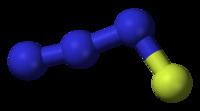Molar mass 61.019 g/mol Appearance Yellow green gas | Boiling point -82 °C | |
 | ||
Related compounds | ||
Fluorine azide or triazadienyl fluoride FN3 is a yellow green gas composed of nitrogen and fluorine with formula FN3. It is counted as an interhalogen compound, as the azide functional group is termed a pseudohalogen. It resembles ClN3, BrN3, and IN3 in this respect. The bond between the fluorine atom and the nitrogen is very weak, leading to this substance being very unstable and prone to explosion. Calculations show the F–N–N angle to be around 102° with a straight line of 3 nitrogen atoms.
Contents
The gas liquifies at –82° and can be turned to a solid at –152 °C.
It was first made by John F. Haller in 1942.
Reactions
Fluorine azide can be made by reacting hydrazoic acid and fluorine gas.
Another way to form it is by reacting sodium azide with fluorine.
Fluorine azide decomposes without explosion at normal temperatures to make dinitrogen difluoride. 2 FN3 → N2F2 + 2N2.
At higher temperatures such as 1000 °C fluorine azide breaks up into nitrogen monofluoride radical. FN3 → FN{a1Δ} + N2.
Solid or liquid FN3 explodes, releasing much heat. A thin film burns at the rate of 1.6 km/s. Because the explosion hazard is great only very small quantities of this substance should be handled at a time. A 0.02 g limit is recommended for experiments.
N3F adducts can be formed with the Lewis acids boron trifluoride (BF3) and arsenic pentafluoride (AsF5) at -196 °C. These molecules bond with the Nα atom.
Shape
The nitrogen atoms in this molecule can be labelled with Greek letters: Nα for nitrogen attached to fluorine, Nβ for the intermediate nitrogen, and Nγ for the terminal nitrogen. The terminal nitrogen can also be labelled Nω.
Distances between atoms are F-N 0.1444 nm, FN-NN 0.1253 nm and FNN-N 0.1132 nm.
Physical
N3F has a density of 1.3 g/cm3.
N3F adsorbs on to solid surfaces of potassium fluoride, but not onto lithium fluoride or sodium fluoride. This property was being investigated so that N3F could boost the energy of solid propellants.
The ultraviolet photoelectric spectrum shows ionisation peaks at 11.01, 13,72, 15.6, 15.9, 16.67, 18.2, and 19.7 eV. Respectively these are assigned to the orbitals: π, nN or nF, nF, πF, nN or σ, π and σ.
